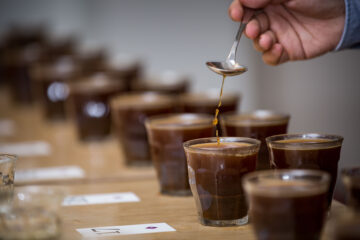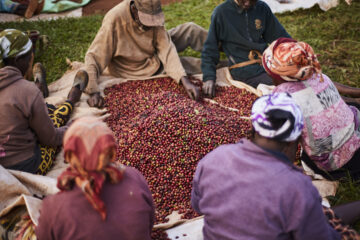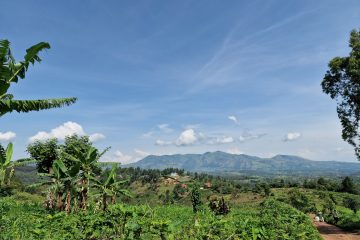Even if many producers in Centrals were hit hard by leaf rust and die-back of trees this year, the producers we work with — the Salaverrias at Las Cruces, Roberto Ulloa at La Divina Providencia and Gilberto Baraona at Los Pirineos — are all doing well.They are doing great work in the fields and have been investing in fertilizer and plant treatments to prevent this. Fortunately their farms are at good altitude which helps to avoid the problems – the hardest-hit farms are mostly below 1400 masl.
Both Tim W and I spent some weeks in Central America during the season this year. I was there in the beginning of January, and Tim went over in February. This way we are able to cover more ground and follow up with cupping, lot selection etc.
Our first shipment should arrive in Oslo at the end of this week (mid-April)! So far we have El Martillo, La Ilusion, San Felipe, La Independencia, El Pedregal, and Santa Julia on their way. All are processed at Las Cruces. The next shipment should be arriving end of March and will contain some more coffees from Las Cruces as well as the La Divina Providencia coffees and some amounts from Los Pirineos. We have samples for the first shipment from Las Cruces, so contact us for samples.

Las Cruces wet mill 2013
The super sweet, balanced, juicy, rich and clean coffees from Las Cruces will be back again this year. The coffees are super solid, and work well as single origin espressos, in blends and are a safe bet for any single origin filter brew.
We will again have a broad selection of coffees from the Salaverria family that owes the Las Cruces mill and a good number of farms surrounding this wet mill. Some of the farms are the same as last year, and some are new to us like La Independencia and El Pedregal. Santa Julia is a farm recently purchased by the family, with all old Bourbon trees, at an altitude of around 1600 masl. We will also have El Martillo, La Ilusion, San Felipe – same farms as last year – in the first container, with a couple more farms to come in the next shipment.
The coffees are in general all from the higher altitudes, with either old bourbon trees or a mix of bourbon, pacas and even some catuai and pacamara trees mixed in some of the blocks.
All the coffees are again going through the same preparation as we initiated last year at Las Cruces together with the producer. Which means: they are going through an extra washing and rinsing, then are soaked in clean water over night after being mechanically demucilaged on Jotagallo eco-pulpers. Read more here from last year’s Las Cruces post…
One benefit of having a long-term partnership is that they now are more experienced with the “new” process and are able to fine-tune to improve even more. As always the cherries are extremely ripe when harvested, and the quality control at the mill is even more impressive than last year. They are focusing more on preparation on selected farms and have a great system for lot separation.
We have found that the soaking process helps these coffees hold up really well in terms of aging. Even if they are dried on patios, they are dried under very well controlled circumstances at higher altitudes, with temperatures at acceptable levels.
These guys are doing a lot of experiments with organic farming as well. They are heavily involved in the development of the organic fertilizer Huisil. It’s widely used for all their coffees, with a minimum 50/50 split with normal traditional fertilizer. A couple of their farms are now 100% converted to organic and there will be more to come.
We have cupped coffees of the same varietal side by side several times on a block with chemical fertilizer VS Huisil (organic), and the cup quality seems to be slightly better for the plants with organic treatment, which is a promising development!

La Divina Providencia 2013
We are continuing our relationship with Roberto Ullua and his farm, La Divina Providencia. He’s definitely producing some of the most complex and unique coffees I know in El Salvador. The farm is located in the Santa Ana region, but is in an area called Pala Campana, which has different soils and a micro-climate compared to the rest of this region. He has a mix of old bourbon trees and the varietal they call Kenyan, which is a varietal planted in that area some generations ago. All together the soil, climate and varietals result in a more acidity-driven, complex and floral coffee than found anywhere else in Central America. For more info see post La Divina Proividencia…
Roberto Ulloa is one of the most passionate farmers I know of in terms of agronomical practices. His approach to coffee farming is all about soil treatment and making the root systems healthy enough to harness the maximum potential of the plant. His philosophy is that the quality is all made in the fields, and that old trees can contribute to more structure and complex flavors. This reminds me of the philosophy of some of the greatest wine producers in Burgundy.
He recently changed the mill where he is processing his coffees from La Gloria to Las Lajas. Even here we are currently doing trials on different processing, fermentation and soaking methods as well as drying on raised tables etc. We will have small amounts from the trials this year of regular washed, soaked, naturals, etc.

Los Pirineos
Gilberto Baraona, the owner and producer of Los Pirineos, has his farm located in Usulatan, east of the Santa Ana region. He’s a progressive farmer experimenting a lot with varietals, processing and drying. He’s taken part in some research project to develop new varietals and this has resulted in a great seed bank with coffee varietals from all over the world. He’s also doing some trials on planting different varietals in different altitudes to see how they perform in terms of flavor.
This year he built a lot of raised drying beds that are covered with shade to both produce naturals and to see the effect of a slower drying on raised tables on cup transparency and flavor. Especially important is whether this way of drying the coffee can extend shelf life and decrease the rapid development of aged flavors that often occurs early in Central American coffees. He’s got his own mill at the farm that allows him and us to do a lot of trials in general to improve the final product.
–Morten


